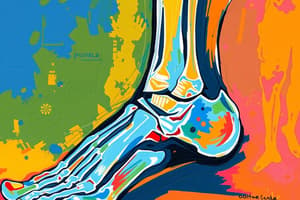Podcast
Questions and Answers
What is considered the mainstay treatment for acute Charcot foot?
What is considered the mainstay treatment for acute Charcot foot?
- Casting therapy (correct)
- Calcitonin injections
- Oral bisphosphonates
- Anabolic agent therapy
Which of the following statements is true regarding antiresorptive therapies for acute Charcot foot?
Which of the following statements is true regarding antiresorptive therapies for acute Charcot foot?
- They significantly reduce skin temperature.
- They have shown a strong support for clinical use.
- They are only available in intravenous form.
- They reduce bone turnover but their effectiveness is still debated. (correct)
What is a potential benefit being studied in relation to 1–84 recombinant human parathyroid hormone?
What is a potential benefit being studied in relation to 1–84 recombinant human parathyroid hormone?
- Improving patient mobility
- Preventing the progression of diabetes
- Speeding up clinical resolution and fracture healing (correct)
- Reduction in foot temperature
Which aspect of casting therapy remains controversial?
Which aspect of casting therapy remains controversial?
What challenges do healthcare professionals face with Charcot arthropathy?
What challenges do healthcare professionals face with Charcot arthropathy?
What is the primary focus of casting therapy in the management of Charcot arthropathy?
What is the primary focus of casting therapy in the management of Charcot arthropathy?
How is the response to casting therapy in Charcot arthropathy typically monitored?
How is the response to casting therapy in Charcot arthropathy typically monitored?
What is the duration of casting therapy for Charcot arthropathy according to various studies?
What is the duration of casting therapy for Charcot arthropathy according to various studies?
Which of the following treatments is part of the medical management of Charcot arthropathy?
Which of the following treatments is part of the medical management of Charcot arthropathy?
What correlation was observed regarding the temperature difference in the context of Charcot arthropathy?
What correlation was observed regarding the temperature difference in the context of Charcot arthropathy?
Study Notes
Charcot Arthropathy Management
- Charcot arthropathy is a significant complication of diabetes.
- Early diagnosis and intervention are crucial for better patient outcomes.
- Casting therapy is considered the primary treatment for acute Charcot foot.
- There is debate regarding casting duration, removable vs. non-removable casts, and weight-bearing vs. non-weight-bearing casts.
Casting Therapy
- Casting therapy aims to offload the foot, reduce mechanical stress, and minimize bone damage.
- Casting duration varies widely across studies, ranging from 9 weeks to 11 months.
- Clinical assessment, infrared thermometry, bone scanning, and skin temperature differences are used to monitor response.
Antiresorptive Therapies
- Bisphosphonates (pamidronate, zolendronate, alendronate) and calcitonin have been studied for acute Charcot.
- These therapies were evaluated through randomized controlled trials.
- Significant reductions in bone turnover were observed with both bisphosphonates and calcitonin, but they don't consistently reduce foot temperature.
Emerging Therapies
- Anabolic agents to promote bone healing are being investigated.
- A clinical trial evaluating the potential benefit of recombinant human parathyroid hormone for fracture healing in acute Charcot foot is ongoing.
- Research into the inflammation-bone resorption connection suggests potential areas for developing novel therapies targeting RANKL or TNF-α.
Progression to Footwear
- Transitioning from casts to shoes is indicated when the foot skin temperature difference is less than 2 degrees Celsius.
- Gradual rehabilitation is essential.
- Rapid mobilization can worsen bone and joint damage.
Key Facts
- There's a strong correlation between skin temperature difference and the ratio of isotope uptake in the affected and unaffected foot (r=0.90, p<0.00001).
- Dynamic MRI is proving valuable in the follow-up of acute Charcot foot.
- Offloading and casting remain the cornerstone of acute Charcot therapy, but the effectiveness of antiresorptive therapies and the benefit of anabolic agents need further research.
Studying That Suits You
Use AI to generate personalized quizzes and flashcards to suit your learning preferences.
Related Documents
Description
Test your knowledge on the management of Charcot arthropathy, a complication of diabetes. This quiz covers topics such as casting therapy, antiresorptive therapies, and the importance of early diagnosis. Assess your understanding of treatment approaches and clinical assessments used in patient care.




